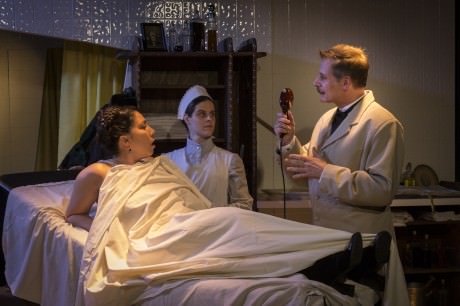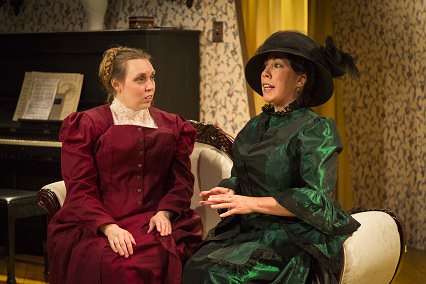The doctor is in at Maryland Ensemble Theatre as they close out their 2013/2014 season with In the Next Room or the Vibrator Play. Directed by Julie Herber, this illuminating comedy covers the intimate particulars of hysteria at the dawning of the electrical era. Connections and sparks are experienced by all throughout the production as emotions are unearthed and sensations are dealt with. Playwright Sarah Ruhl’s charming work is expressed through comic situations and heartfelt moments of true emotional expression making for a deliciously delightful production.

The ridiculously restrictive fashion statement of the American 1880s is displayed in full with Costume Designer Sherry Shaner’s fully corseted costumes. The excessive amount of garments utilized to complete each woman’s looks pays genuine tribute to the form-fitting rigid notions of ladies’ home fashions from the time. Shaner’s use of brightly colored patterns for both the doctor’s wife and the nurse maid who comes to tend the child are a show of society; wealthy families being able to afford finer fabrics. The structural layers of these costumes, including the bustle pouch to make the back of the dress more prominent fulfills the look of the era with ease.
Set Designer Ira Domser creates two distinctive sets within one household; the very proper and simplistically detailed front living room and the very sterile and bleak operating theatre. By uniting these two rooms under one household and allowing them to exist side by side with no visual means of blockage the parallels between what occurs in each of the rooms is more readily viewed by the audience. Working in tandem with Lighting Designer Paul Shillinger, Domser works in ‘electrical surges’ throughout the entire space every time the ‘devices of treatment’ are turned on in the operating theatre.
Director Julie Herber presents a mostly flawless interpretation of Sarah Ruhl’s witty work, though an interpretive dance scene at the play’s finale does feel out of place. While aesthetically stunning with the blend of music from Sound Designers Thom Huenger and Tad Janes and glowing swirling lights from Shillinger, the rest of the cast outside of the doctor and his wife feel strangely superfluous with their interpretive dancing as the scene comes to a close. Otherwise, Herber’s direction is impeccable, crafting intricate relationships among each of the characters and finding stunning moments— often in distracted silence— where character arch’s radiate through the progression of the show.
Annie’s (Vanessa Strickland) moment alone with the machine in the operating theatre is one of these aforementioned moments. Under Herber’s guidance, Strickland takes a simple gesture that would otherwise be glossed over and turns it into a ritual which exposes a deep-seeded vulnerability of her character in a silently haunting and stunningly beautiful moment; a scene-stealing moment in a most striking and profound fashion.
Another moment of excellently crafted emotional wonder comes from Elizabeth (Rona Mensah.) Perhaps the most evocative moment in the production, Mensah delivers a brief monologue to Catherine near the end of the play and its emotional release is paralyzing. Her ability to transport the audience out of the quirky comedy they have witnessed up until that point and into the wells of sorrows that are stirring beneath her mostly quiet exterior is astounding.
Herber’s use of physical comedy in this production creates laughable moments that would otherwise go unnoticed. Employing high-end slapstick, like in the scenes around the operating theatre door with Dr. Givings (Reiner Prochaska) and his wife Catherine (Allison Duvall), the hilarity is drawn up and away from the sexual overtones of the play and into the body, which can indeed be a humorous thing while simultaneously serving as a double entendre. Similar roundabout blocking occurs between Catherine and Mrs. Daldry when the women titter over staying or leaving the living room, and every time a ‘chase’ happens around the sofa’s central gravity a similar blocking strategy is employed.
Prochaska, as Dr. Givings, is mild in his portrayal, aloof and reserved. This is fitting as he is a clinical man of science. There are moments of expression, read mostly through his eyes and spikes in his vocal pitch, that arrive under the guise of excitement or restrained anger. It is the gradual tensions built between Prochaska’s character and Duvall’s character that drive the underlying storyline of love’s labors lost. Duvall gives a well-formulated portrayal of the silly housewife who often speaks her mind without thinking.
Mrs. Daldry (Lia Seltzer) is a character that experiences the most transitions. Arriving as a nervous and clearly excitable woman, Seltzer embodies the character’s hysterics wholeheartedly. Between the trembling in her fingers and the exasperating screams, it is easy to see that her character is, as the Doctor says, unwell. Seltzer eases the shifts of her character into her portrayal; delivering epically hilarious moments of ecstatic joy on the table of the operating theatre. There is something unspeakably genuine about the facial reactions experienced during scenes of ‘treatment’ with Seltzer’s character; a truly inviting performance that is enjoyable for all.

It’s Leo Irving (Jack Evans) who doesn’t even arrive until the second act of the production, that steals away all the attention. Not only because cases of hysteria in males is so rare but because Evans turns the role into a truly remarkable character, keeping all eyes on him every time he moves or speaks. Bordering on the edge of mania, Evans’ portrayal of Leo is spastically neurotic. With an insane enthusiasm his frenetic energy keeps him giggling, tittering, and twitching through every scene he’s in. The level of sheer animation that Evans brings to the character is electrifying; bounding about the room in great strides or leaping up and over the operating table with a frightening flare. Finding comic nuances in the character, like attempting to sit for tea after treatment, Evans develops this side character into a fully blossomed leading role; a brilliant portrayal if ever there was one.
Running Time: 2 hours and 20 minutes, with one intermission.
In the Next Room or the Vibrator Play plays through June 22, 2014 at The Maryland Ensemble Theatre— 31 West Patrick Street in historic Frederick, MD. For tickets call the box office at (301) 694-4744, or purchase them online.





